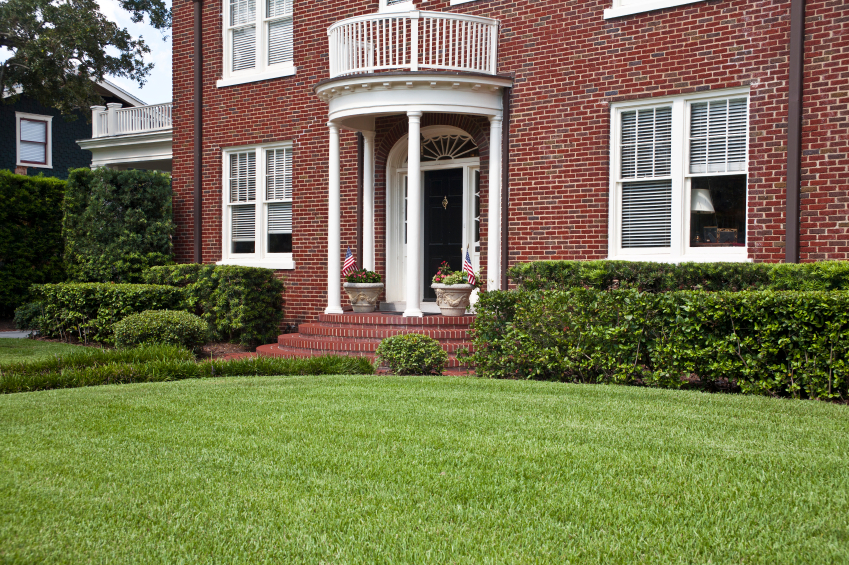There are certain facts that I hold to be true. Dryers eat socks. There is no such thing as a quiet terrier. And lawn maintenance, not baseball, is the great American pastime. Every spring weekend my neighbors hold the equivalent of the World Series in establishing who has the greenest grass.
For a long time I wondered why we don’t find English gardens in America. True, we cannot grow many of the English garden's traditional plants. True, few of us have enough property to rival Sissinghurst with its myriad of garden rooms. However, the real reason lies in the American fetish for grass. Who would have the nerve to plant a front yard cottage garden, thereby breaking up the long panorama of lawn in our suburban developments?
The U.S. has over 32 million acres of grass in cultivation — we plant more grass than we do wheat, corn, or tobacco put together. The lawn and garden do-it-yourself industry rakes in $25 billion yearly. Without a doubt, lawn care has turned into a civic duty, incurring wrath upon the poor neighbor who fails to maintain and mow his lawn in an adequate fashion.
How did this obsession arise? The great American lawn appeared after the Civil War with the development of suburban communities. Previously lawns were a luxury enjoyed by the upper classes. In 1868, Frederick Law Olmstead designed Riverside, just outside of Chicago. Disliking the high walls employed by the English, Olmstead stipulated that not only would there be no walls, but each house would be placed 30 feet from the road. He wanted a seamless lawn vista, leaving the impression all Riverside residents lived in a single park. Accordingly, nothing was to break up this sweeping scenic view.
The other important name in this story is that of Frank J. Scott, whose influential 1870 book, “The Art of Beautifying Suburban Home Grounds,” stated that, “A smooth, closely-shaven surface of grass is by far the most essential element of beauty on the grounds of a suburban house.” Scott’s prose, tending toward the overly florid, included this wonderful nugget: “Let your lawn be your home’s velvet robe and your flowers its not too promiscuous decoration.” Hedges were “unchristian,” as they hid from others “the beauties of nature which it has been our good fortune to create or secure.”
It was Scott who condemned American suburbanites to weekend torture when he declared that “no lawn can be brought to perfection if cut less often than once a week.” Those who recoiled from following his dictates were “slatterns,” while the appearance of dandelions was surely an indication of sloth. What new home owner dared to carry the epithet of slattern?
All this is particularly startling when you realize that it wasn’t always easy to cut grass in the late 19th century. In the 18th century, grazing animals, scythes, and sickles did the job, but the first American reel-type mower, powered by horses, was patented in 1868, just in time to harness the Riverside lawns. A human-powered machine was introduced in 1870, followed by the rotary blade lawn mower in 1899. It took a lot of time and effort to avoid the designation of “slothful.”
The emphasis on a beautiful grass lawn has turned our front yards into our public face, one we venture out in rarely, as we feel we’re on exhibition. In many areas of the country, lawns are unnatural creations, unsuitable for the environment. Parts of Arizona, Nevada and North Dakota have lawns — all places where lawns are not what nature intended. Yet many homeowner associations and even towns persist in mandating that homeowners maintain a lawn in their front yards. Despite Michelle Obama’s pleas, growing vegetables in the front yard is considered improper by many communities, judging by the number of New York Times stories on this topic over the past five years.
In Michael Pollan’s judgment, the lawn is actually anti-garden — an opinion I happen to share. Grass should not dominate the garden but instead should be a contrasting element. After all, there are more interesting plants than grass. Indeed, the real question is this: Can you have a garden when grass is the dominant feature?
However, do not despair as we have made some progress in curbing our obsession with lawn maintenance. In the April 1944 issue of House Beautiful, there was an ad for Vigoro fertilizer: “Probably you, too, have a loved one in the service. … Wherever he is he dreams of velvety lawns … He wants to come home to them. Keep them growing their best awaiting that day! They will contribute immeasurably toward a winning home front.” Thankfully, both political parties in the ongoing debate on the wars on terror, Iraq, and Afghanistan have spared us this sentiment. Now that is progress.









